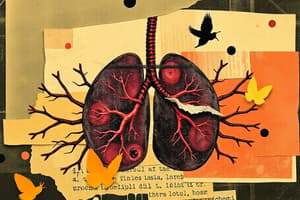Podcast
Questions and Answers
چه بخشی از میتوکندری ظرفیت بیشتری از سطح برای پروتئینهای حاوی آنزیم دارد؟
چه بخشی از میتوکندری ظرفیت بیشتری از سطح برای پروتئینهای حاوی آنزیم دارد؟
فرایند تولید ATP در میتوکندری با چه نامی شناخته میشود؟
فرایند تولید ATP در میتوکندری با چه نامی شناخته میشود؟
کدام فرایند در میتوکندری به تولید NADH و FADH2 منجر میشود؟
کدام فرایند در میتوکندری به تولید NADH و FADH2 منجر میشود؟
مشکلات در عملکرد میتوکندری ممکن است به کدام نوع از بیماریها منجر شود؟
مشکلات در عملکرد میتوکندری ممکن است به کدام نوع از بیماریها منجر شود؟
Signup and view all the answers
کدام فرایند از این فرایندها در فضای سایتوپلاسم اتفاق میافتد؟
کدام فرایند از این فرایندها در فضای سایتوپلاسم اتفاق میافتد؟
Signup and view all the answers
چه قسمت از محتوای باقيمانده دستگاه گيرندهي خارجي حاوي؟
چه قسمت از محتوای باقيمانده دستگاه گيرندهي خارجي حاوي؟
Signup and view all the answers
چه بخشی از سلول برای تولید انتیپی مورد نیاز توسط زنجیره انتقال الکترون مسئول است؟
چه بخشی از سلول برای تولید انتیپی مورد نیاز توسط زنجیره انتقال الکترون مسئول است؟
Signup and view all the answers
چرا اکسیژن به عنوان پذیرندهٔ الکترون نهایی در زنجیره انتقال الکترون مهم برای تنفس سلولی است؟
چرا اکسیژن به عنوان پذیرندهٔ الکترون نهایی در زنجیره انتقال الکترون مهم برای تنفس سلولی است؟
Signup and view all the answers
به چه دو دستهای مشکلات و بیماریها که به علت نقص عملکرد میتوکندری ایجاد میشوند، اطلاق میشود؟
به چه دو دستهای مشکلات و بیماریها که به علت نقص عملکرد میتوکندری ایجاد میشوند، اطلاق میشود؟
Signup and view all the answers
فعال شدن چه چیز میتواند منجر به تولید کمتر ATP یا تولید فعالگازهای اکسیدان خورده (ROS) شود؟
فعال شدن چه چیز میتواند منجر به تولید کمتر ATP یا تولید فعالگازهای اکسیدان خورده (ROS) شود؟
Signup and view all the answers
خودکارامد بودن چه بخشهای مختلف میتوکندری، چگونگی تولید کارآمد ATP را تضمین میکند؟
خودکارامد بودن چه بخشهای مختلف میتوکندری، چگونگی تولید کارآمد ATP را تضمین میکند؟
Signup and view all the answers
بر طبق مطالب فوق، چه نقش برای محافظت از سلامت سلول وجود دارد؟
بر طبق مطالب فوق، چه نقش برای محافظت از سلامت سلول وجود دارد؟
Signup and view all the answers
Study Notes
Mitochondria
Mitochondria are organelles found within most eukaryotic cells that play a crucial role in dividing energy-producing reactions. They were discovered by a Dutch scientist named Leeuwenhoek in the late 17th century through microscopy. Since then, they have been recognized as the powerhouse of the cell due to their primary function of generating adenosine triphosphate (ATP), which is used as a direct source of chemical energy for various cellular processes.
Structure
The structure of a mitochondrion consists of two membranes, an inner membrane, and an outer membrane. The inner membrane is folded into numerous infoldings known as cristae, which increase the surface area for enzyme-containing proteins. The intracellular matrix, which is the space between the two membranes, contains enzymes, ribosomes, and proteins involved in cellular metabolism.
ATP Production
The process of ATP production in mitochondria is called cellular respiration. It involves a series of reactions that occur in three stages: glycolysis, the citric acid cycle (also known as the Krebs cycle), and the electron transport chain. Glycolysis, an anaerobic process, occurs in the cytoplasm and produces two molecules of ATP and two molecules of pyruvate. The citric acid cycle occurs within the mitochondria and produces ATP, NADH, and FADH2. The electron transport chain, also within the mitochondria, generates ATP through the process of oxidative phosphorylation.
Role in Cellular Respiration
The electron transport chain is responsible for generating most of the ATP needed by the cell. Oxygen is used as the final electron acceptor in the electron transport chain, which is why it is crucial for cellular respiration. The mitochondria, therefore, can be considered the primary site of oxidative metabolism and ATP production.
Dysfunction and Diseases
Dysfunction in mitochondrial function can lead to various diseases, collectively known as mitochondrial diseases. These diseases can be caused by mutations in mitochondrial DNA (mDNA) or nuclear DNA (nDNA). These mutations can result in reduced ATP production or increased reactive oxygen species (ROS) production, leading to oxidative stress and cellular damage. Common mitochondrial diseases include mitochondrial encephalomyopathies, Leigh syndrome, and MELAS syndrome.
In summary, mitochondria are essential organelles that play a vital role in generating ATP through cellular respiration. Their structure, including the inner and outer membranes, cristae, and intracellular matrix, allows for efficient ATP production. Dysfunction of mitochondria can lead to various diseases, highlighting the importance of maintaining optimal mitochondrial function for cellular health.
Studying That Suits You
Use AI to generate personalized quizzes and flashcards to suit your learning preferences.
Description
Test your knowledge on the structure and function of mitochondria, the powerhouse of the cell responsible for ATP production through cellular respiration. Learn about the membranes, cristae, intracellular matrix, ATP production stages, and the role of mitochondria in cellular metabolism and diseases.




